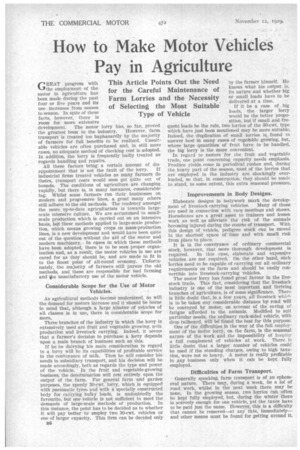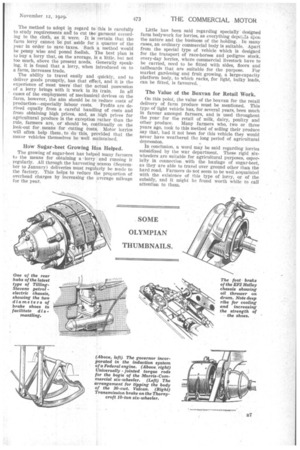How to Make Motor Vehicles Pay in Agriculture
Page 144

Page 145

If you've noticed an error in this article please click here to report it so we can fix it.
GREAT progress with the employmentof the motor in agriculture has been made during the past four or five years and its use increases from season to season. In spite of these facts, however, there is room for more extensive development. The motor lorry has, so far, proved the greatest boon to the industry. However, farm transport is treated too haphazardly by the majority of farmers for full benefits to be realized. Unsuitable vehicles are often purchased and, in still more cases, no adequate method of checking cost is adopted. In addition, the lorry is frequently badly treated as regards handling and repairs.
All these factors bring" a certain amount of dis appointment that is not the fault of the lorry. If industrial firms treated vehicles as many farmers do theirs, transport costs would soon get quite out of bounds. The conditions of agriculture are changing rapidly, but there is, in many instances, considerable lag. Whilst some farmers run their businesses on modern and progressive lines, a great many others still adhere to the old methods. The tendency amongst the more up-to-date agriculturists is towards largescale intensive culture. We are accustomed to smallscale production which is carried out on an intensive basis, but these methods applied to large-scale production, which means growing crops on mass-production lines, is a new development and would have been quite out of the question without the aid of the motor and modern machinery. In cases in which these methods have been adopted, there is to be seen proper organization and, as a result, the motor vehicles in use are cared for as they should be, and are made to fit in to the finest point of all-round economy. Unfortunately, the majority of farmers still pursue the old methods, and these are responsible for bad farming and ihe unsatisfactory use of the motor vehicle.
Considerable Scope for the Use of Motor Vehicles.
As agricultural methods become modernized, so will the demand for motors increase and it should be borne In mind that, although •a large number Of vehicles of all. classes is in use, there is considerable Scope for more, Three branches of the industry in which the lorry is extensively used are fruit and vegetable growing, teak production and livestock carrying Indeed, it seems that a farmer's decision to purchase a lorry depends upon a_ main branch of business such as this.
If he. be dairying his main consideration in regard to a lorry will be its capabilities of profitable service in the conveyance of milk. Then he will consider his needs in subsidiary transport, and his decision will be made accordingly, both as regards the type and power of the vehicle. In the fruit and vegetable-growing business, the determination will rest entirely upon the output of the farm. For general farm and garden purposes, the speedy 30-cwt. lorry, which is equipped with pneumatic tyres and with a specially constructed body for carrying bulky loads, is undoubtedly the favourite, but one vehicle is not sufficient to meet the demands of large-scale methods of production. In this instance, the point has to be decided as to whether it will pay better to employ two 30-cwt. vehicles or one of larger capacity. This item can be decided only by the farmer himself. He knows what his output is, its nature and whether big or small loads have to be delivered at a time.
If it be a case of big loads, the larger lorry would be the better proposition, but if small and frequent loads be the rule, two lorries of the 30-cwt. type which have just been mentioned may be more suitable. Indeed, the 'duplication of small lorries is found to answer best in many cases of vegetktble growing, but, where large quantities of fruit have to be handled, the big lorry is the more convenient.
In regard to motors for the fruit and vegetable trade, one point concerning capacity needs emphasis. Produce yields come in periodical rushes and, during the heavy part of the season, most of the lorries that are employed in the industry are shockingly overloaded, so that, in construction, they should be made to stand, to some extent, this extra seasonal pressure.
Improvements in Body Designs.
Elaborate designs in bodywork mark the develop
ment of livestock-carrying vehicles. Many of these are used in connection with race meetings and shows. Horseboxes are a great asset to trainers and lessen work as well as alleviate the risk of the animals becoming injured during the -courSe of transport. With this design of vehicle, pedigree stock can be moved in the shortest spaCe of time and with small risk from place to place.
It is in the conveyance of ordinary commercial stock, however, that more thorough development is required. In this case, elaborate and expensive vehicles are not required: On the other hand, such lorries need to be capable of carrying out all ordinary requirements on the farm and should be easily convertible into livestock-carrying vehicles.
The motor lorry has found great favour in the livestock trade. This fact, considering that the livestock industry is one of the most important and thriving branches of agriculture, is of some significance. There is little doubt that, in a few years, all livestock which is to be taken any considerable distance byl road will be conveyed by motor, on account of thesaving of fatigue afforded to the animals. Modified to Suit particular needs, the ordinary rack-sided vehicle, With drop tailboard, will be found the best for this purpose.
One of the difficulties in the way of the full employment of the motor lorry, on the farm, is the seasonal nature of the -Work and the impossibility of keeping a full complement of vehicles at work. There is little doubt that a larger number of vehicles could be used if the standing charges, owing to high taxation, were not so heavy. A motor is really profitable in any business only when it can be kept fully employed.
Difficulties of Farm Transport.
Generally speaking, farm transport is of an ephemeral nature. There may, during a week, be a lot of road work, whilst in the next week there may be none. In the growing season, two lorries can _often be kept fully employed, but, during the winter there is scarcely enough for one vehicle, yet the taxes have to he paid just the same. However, this is a difficulty that cannot be removed—at any rate,' immediately— and other means must be found for getting around it. The method to adopt in regard to this is carefully to study requirements an to cut the garment according to the cloth, as it were. It is certain that the farm lorrY cannot be put aside for a quarter of the year in order to save taxes. Such a method would be penny wise and pound foolish. The best plan is to buy a lorry that, on the average, is a little, but not too much, above the present needs. Generally speaking, it is found that a lorry, when introduced on to a farm, increases trade.
The ability to travel easily and quickly, and to deliver goods promptly, has that effect, and it is the experience of most users that the actual possession of a lorry brings with it work in its train. In all cases of the employment of mechanical devices on the farm, however, the aim should be to reduce costs of
production—especially labour costs. Profits are derived equally from a careful handling of costs and from obtaining high prices, and, as high prices for agricultural produce is the exception rather than the rule, farmers are, or should be, continually on the look-out for means for cutting &oats. Motor lorries will often help them, to do this, provided that the motor vehicles themselves be well maintained.
HOw Sugar-beet Growing Has Helped.
The growing of sugar-beet has helped many farmers to the means for obtaining a 'lorry and running it regularly. All through the harvesting season (September to January) deliveries must regularly be made to the factory. This helps to reduce the proportion of overhead charges by increasing the average mileage for the year.
Little has been said regarding specially designed farm bodywork for lorries, as everything depe--4.s irpon the nature and the business of the holding. In many cases, an ordinary commercial body is suitable. Apart from the special type of vehicle which is designed for the transport of race-horses and pedigree stock, every-day lorries, where commercial livestock have to be carried, need to be fitted with sides, floors and
tailboards that are suitable for the purpose. For market gardening and fruit growing, a large-capacity platform body, to which racks, for light, bulky loads, can be fitted, is favoured. .
The Value of the Boxyan for Retail Work.
On this point, the value of the boxyan for the retail delivery of farm produce must be mentioned. This type of light vehicle has, for several years, been much In favour amongst farmers, and is used throughout the year for the retail of milk, dairy, poultry and other produce. Many farmers who, two or three years ago, took to this method of selling their produce. say that, had it not been for this vehicle they would never have weathered the long period of agricultural depression.
In conchision, a word may be said regarding lorries subsidized by the war department. These rigid sixwheelers are suitable for agricultural purposes, especially in connection with the haulage of sugar-beet, as they are able to travel over ground other [hail the hard road. Farmers do not seem to be well acquainted with the existence of this type of lorry, ox of the subsidy, and it might be found worth while to call attention to them.








































































































































































































































































































































